Childhood Diseases
advertisement
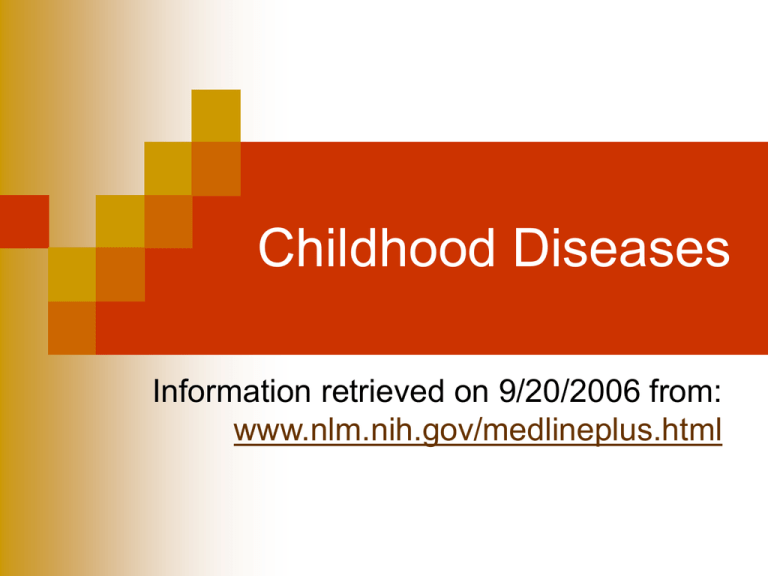
Childhood Diseases Information retrieved on 9/20/2006 from: www.nlm.nih.gov/medlineplus.html Infectious Mononucleosis AKA Mono, “Kissing Disease”, Epstein-Barr Viral Syndrome Cause: Epstein-Barr virus and Cytomegalovirus Both from the herpes virus family Incubation period: 7-14 days Commonly transmitted by saliva and close contact MC age group affected is 15-17 year olds Infection may occur at any age Younger children often don't have symptoms Older patients may have fatigue for up to 6 weeks Gradual onset of symptoms including: Sore throat Fever Headache Fatigue Sore throat becomes progressively worse often accompanied by enlarged tonsils with a whitish yellow covering. Enlarged lymph lodes MC cervical & axillary Cervical lymph nodes often painful Rash Pink, measles-like rash more common if given amoxicillin for throat infection Enlarged spleen & liver Common tests for EB virus include: A monospot test (positive for infectious mononucleosis) Epstein-Barr virus antigen by immunoflouresence (positive for EBV) Epstein-Barr virus antibody titers Management Antiviral medications do not help Most patients recover within 2-4 weeks without medication Fatigue usually resolves within a few weeks may linger for 2 to 3 months To relieve typical symptoms… Gargle Rest & with warm salt water (sore throat) fluids Avoid contact sports while the spleen is enlarged Rubella AKA Three day measles; German measles Viral infection Contagious 1 week before onset of rash until 1-2 weeks after rash disappears Spread through the air or by close contact May be transmitted to fetus by a mother with an active infection Rubella is usually a mild, self-limited infection Children generally have few symptoms Signs & Symptoms Low-grade fever (<102 F) Headache,malaise, runny nose,bloodshot eyes Rash with skin redness or inflammation Complications: Congenital rubella syndrome Transient arthritis common in adolescents and adults with rubella Otitis Media (rare) Encephalitis (rare) Tests: A rubella serology A nasal or throat swab for viral culture Lifelong immunity to the disease follows infection A rubella vaccine is available Congenital Rubella Syndrome “About 25% of infants born to mothers infected with rubella during early pregnancy will develop congenital rubella syndrome associated with a poor outcome.” Defects related to congenital rubella are more common during early pregnancy Complications Deafness are rare after the 20th week (MC) Cataracts Cardiac defects Mental retardation Microcephaly Miscarriage or stillbirth may occur Rubeola AKA Measles, Red Measles Viral infection Incubation period: 8 to 12 days before symptoms generally appear Spread by contact with droplets from the nose, mouth, or throat of an infected person Signs & Symptoms: Sore throat,runny nose, cough, muscle pain, fever, bloodshot eyes Koplik's spots White spots inside the mouth Photophobia Complications: Secondary bacterial infections otitis media, bronchitis, or pneumonia Encephalitis (~1/1000) Tests: Viral culture (rarely done) Measles serology Immunity occurs after active infection A vaccine is available Fifth Disease AKA Parvovirus B19, erythema infectiosum, “slapped cheek” A viral illness characterized by mild symptoms and a blotchy rash Once the rash appears, the patient is noncontagious and may return to school or day care First sign noticed by parents: bright red cheeks Later a rash appears on the extremities and trunk Fades from the center outwards giving it a “lacy appearance” Rash disappears entirely in 1-2 weeks Complications Generally no complications in normally healthy children Mild and generally benign viral infection Complete recovery can be expected Tests Blood tests for antibodies against Parvovirus B19 are available Varicella AKA Chicken Pox Cause: varicella-zoster (herpesvirus family) also causes herpes zoster (shingles) in adults Very contagious; can be spread by direct contact, droplet transmission, or airborne transmission A vaccine is available Usually occurs in children younger than ten Adults and older children usually get sicker than younger children Characterized by vague symptoms (fever, headache, tummy ache, or loss of appetite) for 1-2 days before the classic pox rash appears These symptoms generally last 2 to 4 days after the rash appears Itchy fluid-filled blisters develop over red spots on the skin (dew drops on a rose petal) Often appear first on the face, trunk, or scalp and spread from there Complications: Secondary infection of the blisters may occur Reyes syndrome, pneumonia, myocarditis, and transient arthritis Cerebellar ataxia may appear during the recovery phase or later Encephalitis (rare) Congenital infection Newborns are at risk for severe infection (if mother is not immune) Chickenpox is usually diagnosed from the classic rash and the child's medical history Tests: Blood tests and tests of the pox blisters themselves can confirm the diagnosis if there is any question Treatment Antiviral medicines skin conditions (eczema or recent sunburn) lung conditions (asthma) recently taken steroids take aspirin on an ongoing basis In most cases, it is enough to keep children comfortable while their own bodies fight the illness… Treatment: Trim the fingernails reduce secondary infections and scarring Oatmeal and/or baking soda baths Topical lotions Oral antihistamine Roseola Caused by a human herpesvirus 6 Incubation period: 5 to 15 days Spread either through fecal-oral contact or via airborne droplets Common in children 3 months to 4 years old MC in those between 6 months and 1 year Classic presentation Fever (up to 105 F) ~3 days (may last 7) Fever falls between the 2nd and 4th day As the fever falls, the rash appears First on the trunk and then spreads to the limbs, neck, and face Rash lasts from a few hours to two days Symptoms: Abrupt onset of high fever Irritability Rash erupts on the 4th or 5th day of the illness (fever has usually resolved or is dropping by the time the rash appears) Signs: A history of roseola in the community A physical exam of rash Swollen occipital lymph nodes The vast majority of children with roseola fully recover Complications: Febrile Seizure Encephalitis (rare) Aseptic meningitis (rare) Treatment : No specific treatment usually resolves without complications Medical Management: Acetaminophen and sponge baths (fever) If convulsions occur ~>medical evaluation Hand-Foot-and-Mouth Disease AKA Coxsackievirus infection MC in young children can be seen in adolescents and occasionally adults Outbreaks occur most often in the summer and fall Symptoms Fever Sore throat Loss of appetite Headache Ulcers in the throat, mouth & tongue Vesicular rash on hands, feet, & diaper area Infection usually begins in the throat Hands, feet, and diaper area are affected by a vesicular rash (very small blisters) Typically on the palm side of the hands & the sole side of the feet Tender or painful if pressed Expectations: Usually a mild illness Generally complete recovery occurs in 5-7 days Complications: Dehydration may occur mouth lesions cause pain with swallowing Possible febrile seizures Scarlet Fever AKA Scarlatina Cause: group A streptococcal throat infection Incubation period: generally 1-2 days Symptoms: Sore throat Fever, chills Abdominal pain, vomiting Headache Muscle aches Generalized discomfort (malaise) Swollen, red “strawberry tongue” Rash on neck and chest Pastia's lines bright groin red color in the creases of the underarm and Typically begins with fever & sore throat Strep. produces a toxin that causes a rash Appears 1-2 days after the onset of illness Usually appears on the neck & chest, then spreads over the body Described as "sandpapery" in quality Can last for over a week As the rash fades, peeling (desquamation) may occur (finger tips, toes, and groin area) Diagnosis: Physical examination texture of the rash is more important than the appearance in confirming the diagnosis Tests: Throat culture positive for Group A Strep Rapid antigen detection (throat swab) Scarlet fever was once a very serious childhood disease, but now is easily treatable… Expectations: With proper antibiotic treatment, symptoms should resolve quickly Rash can last for up to 2-3 weeks before it is fully resolved Treatment: Antibiotic therapy Crucial to preventing rheumatic fever Complications are rare with proper treatment Complications include: Acute rheumatic fever Ear infection Adenitis or abscess Pneumonia Sinusitis Meningitis Bone or joint problems (osteomyelitis Liver damage (hepatitis) Kidney damage (glomerulonephritis) or arthritis) Mumps AKA Epidemic parotitis Viral infection Incubation period: 12 to 24 days Spread from person-to-person by respiratory droplets or articles contaminated with infected saliva MC in children between the ages of 2 and 12 can occur in other age groups Acute, contagious, viral disease Causes painful enlargement of the salivary or parotid glands Other organs may be involved including the testes, the CNS, and the pancreas After the illness, life-long immunity to mumps occurs A vaccine is available Symptoms: Face pain Swelling of the parotid glands Fever Headache Sore throat Swelling of the temples or jaw Additional symptoms in males: testicle pain & scrotal swelling Diagnosis: Physical examination confirms the presence of the swollen glands No testing is usually required Treatment No specific treatment Probable outcome is good even if other organs are involved Recommendations: Warm salt water gargles, soft foods, and extra fluids Intermittent ice or heat to the affected area Acetaminophen for pain relief Diphtheria Cause: toxin-producing Corynebacterium diphtheriae Incubation period: 2 to 5 days Transmission: Contact with respiratory droplets from infected persons or asymptomatic carriers May also be transmitted by contaminated objects or foods Diphtheria may be mild and unrecognized or it may become progressive The bacteria primarily infect the nose and throat Produces a characteristic membrane that is gray to black, tough, and fibrous Membrane can cause airway obstruction Symptoms : Sore throat mild to severe; painful swallowing; hoarseness Drooling (airway obstruction) Fever and chills Bloody, watery drainage from nose Croup-like (barking) cough Stridor, difficulty breathing, or rapid breathing Apnea; Cyanosis Note: There may be no symptoms. Complications Diphtheria toxin can damage the heart, nervous system, kidneys, or other organs resulting in disorders such as: Myocarditis ~> heart failure Neurologic palsies or peripheral neuritis ~> uncoordinated movements (develops in 3-7 weeks) Severe nerve damage ~> paralysis Kidney damage or nephritis Diagnosis Characteristic gray pseudomembrane Enlarged lymph glands, swelling of the neck or larynx Tests Gram stain of membrane or throat culture to identify Corynebacterium diphtheriae If diphtheria is suspected, treatment should be started immediately, even before the results of bacterial tests are available. Treatment : Diphtheria antitoxin intramuscular or IV injection as soon as the diagnosis is suspected Infection is then treated with antibiotics penicillin or erythromycin A vaccine is available Pertussis AKA: Whooping cough Highly contagious bacterial disease Spread through respiratory droplets Symptoms Runny nose Slight fever (102°F or lower) Diarrhea Severe, repeated coughs May lead to vomitting May make breathing difficult May cause a short loss of consciousness Choking spells in infants In children, the coughing often ends with a "whoop" Produced when the patient tries to take a breath Rare in patients under 6 months and in adults The infection usually lasts 6 weeks Cold symptoms (~2 weeks) Progressively worse cough (~4 weeks) Complete resolution (may take months) Diagnosis Usually based on symptoms When symptoms are not obvious, pertussis may be difficult to diagnose… Differentials In very young infants, symptoms may be caused by pneumomnia instead Complications Nose bleeds Ear infections Pneumonia Slowed or stopped breathing (apnea) Convulsions Seizure disorder (permanent) Brain damage from lack of oxygen Bleeding in the brain (cerebral hemorrhage) Mental retardation Death Expectations: In older children, outlook is generally very good Infants have the highest risk of death and need careful monitoring Management Cough mixtures, expectorants, and suppressants are usually not helpful and should NOT be used Treatment: Infants <18 months require constant supervision Breathing Infants with severe cases should be hospitalized An may stop during coughing spells oxygen tent with high humidity may be used If started early enough antibiotics can spead up resolution IV fluids (severe coughing spells prevent the patient from drinking enough fluids) A vaccine is available Tetanus AKA: Lockjaw Spores in the dirt, NOT rusty nails Cause: toxin of the bacteria C. tetani Spores of the bacterium live in the soil and are found around the world (can remain infectious >40 years) Incubation period: 5 days to 15 weeks, 7 days average A vaccine is available Infection begins when the spores are introduced into an injury or wound. Symptoms: Spasms and tightening of the jaw muscle "lockjaw" Stiffness and spasms of various muscle groups neck, chest, abdominal, and back muscles “opisthotonos” Tetanic seizures painful, Irritability Fever powerful bursts of muscle contraction Additional symptoms that may be seen: Excessive sweating Swallowing difficulty Hand or foot spasms Drooling Uncontrolled urination and/or defecation Complications: Airway obstruction Respiratory arrest Heart failure Pneumonia Fractures Brain damage due to lack of oxygen during spasms Treatment: Antitoxin (control and reverse the tetany) Antibiotics (kill C. tetani) Wound debridement Treat symptoms Bedrest with a nonstimulating environment may be recommended Sedation may be necessary (keep the patient calm) Respiratory support with oxygen, endotracheal tube, and mechanical ventilation may be necessary
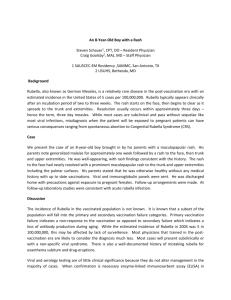

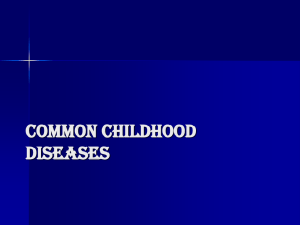
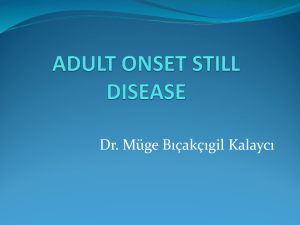

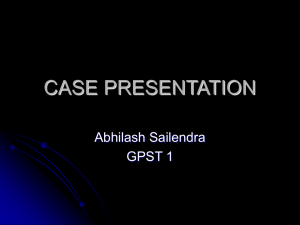
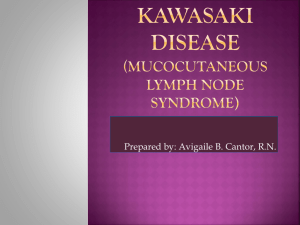
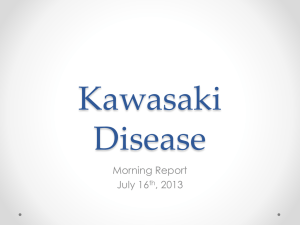


![Mistry-VisualDiagnosis12-5-07[2]](http://s2.studylib.net/store/data/005753399_1-f3c8e8f06b6b9b9f31dbd547ba21de96-300x300.png)
